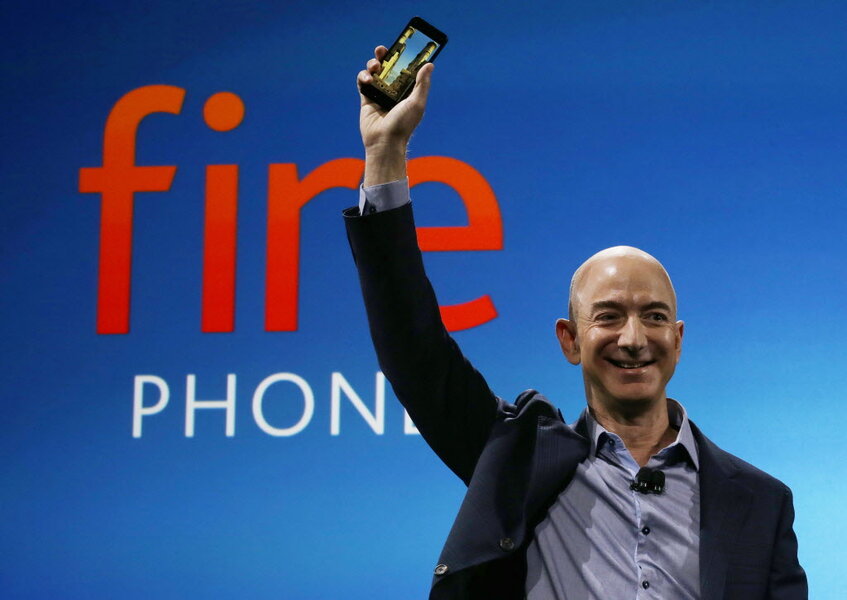Amazon unveils its Fire Phone: Business game-changer or gaffe?
Loading...
| Los Angeles
As Big Tech announcements go, Amazon’s unveiling of its new Fire Phone could either be a game-changer for the mobile industry or a serious misstep by a normally savvy business giant, say tech and marketing experts who have been watching the buildup to Wednesday’s news with growing interest.
The new smart phone, touted by Amazon CEO Jeff Bezos at an event in Seattle, features a slew of nifty updates to the handheld experience. These include 3D visuals that make objects pop out from the screen, a 13 megapixel, rear-mount camera, and onboard emergency help buttons that Kindle users will recognize from the Fire tablet.
But perhaps the most important update from the standpoint of redefining the mobile experience is Firefly, the visual recognition software that will allow users to point their phones at, and locate where to buy, some 100 million objects – Amazon hopes from within its own universe.
“The goal is to create an entire eco-system,” says Moshe Cohen, a professor at Columbia University Business School in New York. The name of the game, he says, is to eliminate the divide between hardware and software and the services these provide by making the interactions as simple as pointing a phone at what you want, he points out.
“The strategy now is to get the average person to use more services and have a better experience,” adds Professor Cohen.
However, this leap into a marketplace that is already extremely competitive is potentially a significant blunder, say some analysts. Most consumers are already committed to one mobile phone format, with years of downloading apps and personalizing functions on their mobile phones, says marketing expert Kevin Paul Scott, founder of the financial advisory firm ADDO Worldwide and author of the marketing book, “8 Essential Exchanges for your query.”
In addition, the contracts offer little incentive to buy the phone. The 32 gigabyte and 64 gigabyte versions come exclusively with two-year AT&T contracts at $199 and $299 respectively, higher price points than expected.
Most important, he points out, there is a perception gap in making such a significant switch.
“People understand Amazon as a marketplace, not a phone manufacturer,” he says. People are more comfortable buying a product from a company that has a reputation for doing a great job with whatever the product may be.
“People buy televisions from TV manufacturers, and so on,” he says. Apple has been able to sell consumers on a range of new products, he points out, “because the company has a reputation for innovating and so people expect new products from them.”
Amazon’s failure to break out with Kindle should have raised a cautionary flag for the company, says Mr. Scott. Sales figures on competing tablets tell the story, he says. While Apple has sold some 16 million tablets in the past year, Amazon’s Kindle has sold only a million.
The problem in marketing a smart phone for Amazon, says Scott, is that this sends the message to both everyday consumers as well as shareholders that not only does the company not understand how consumers perceive the company, but by pressing ahead with a misconceived strategy, it may not be handling its business affairs well.
However, the shift toward making technology ever simpler to use is further along than many even realize, says Michael Ni, chief marketing officer at Avangate, a digital commerce consulting firm,
"You see the signs around you every day,” he says via e-mail, whether it is listening to your Internet radio, virtually hailing your Uber limo ride, or finding and paying a flat fee for legal document creation instead of by the hour. We are surrounded by services.
“They have become so pervasive, we don’t even think of them as we use them. Services are being productized and are now more accessible and easy to consume,” he says.
At the same time, adds Mr. Ni, starting from when the salesperson at Best Buy tries to sell you insurance for whatever you just bought and including the fact that Amazon pitches the Kindle or even the new 3D smart phone as a platform for content and services, products are increasingly an excuse to sell more services, he says.
He adds that these are “services that are beyond just one sale, but an ongoing and more predictable revenue relationship with each customer."







